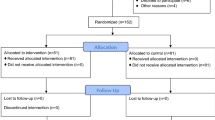Abstract
Introduction Over half of surveyed college students are experiencing pain they are attributing to computer use. The study objective was to evaluate the effect of computing patterns on upper extremity musculoskeletal symptoms. Methods Symptom experiences and computing/break patterns were reported several times daily over three weeks for 30 undergraduate students over a semester. Two-level logistic regression models described the daily association between each computing pattern and both any and moderate or greater symptom experienced, adjusting for covariates. Results The associations between most computing/break patterns and experiencing any symptoms were positive: total hours of computer use adjOR = 1.1 (90% CI 1.1–1.2), 1–2 breaks versus none adjOR = 1.3 (90% CI 0.9–1.9), 3–6 breaks versus none adjOR = 1.5 (90% CI 1.1–2.2), >15 min break versus none adjOR = 1.6 (90% CI 1.1–2.2), and number of stretch breaks adjOR = 1.3 (90% CI 1.1–1.5). However, breaks for less than 15 min were negatively associated with experiencing any symptoms: adjOR = 0.6 (90% CI 0.5–0.9). The associations between most computing/break patterns and experiencing moderate or greater symptoms were positive: total hours of computer use OR = 1.1 (90% CI 1.1–1.2), 1–2 breaks and 5–6 breaks versus none OR = 1.8 (90% CI 1.1–2.9), 7–8 breaks versus none OR = 2.0 (1.0–4.2), >15 min break versus none 1.8 (1.1–3.1), and number of stretch breaks OR = 1.3 (1.0–1.5). Conclusion Computing/break patterns were consistently associated with experiencing symptoms. Our findings suggest evaluating breaks with computing duration (computing patterns) is more informative than assessing computing duration alone and can be used to better design ergonomic training programs for student populations that incorporate break times.
Similar content being viewed by others
References
National Research Council and Institute of Medicine. Musculoskeletal disorders and the workplace. Washington, DC: National Academy Press; 2001.
United States Census Bureau. Computer and Internet use in the United States. Available at http://www.census.gov/prod/2005pubs/p23-208.pdf (2003).
Village J, Rempel D, Teschke K. Musculoskeletal disorders of the upper extremities associated with computer work: a systematic review. Occup Ergo 2005;5:205–18.
Katz JN, et al. Prevalence of upper extremity musculoskeletal disorders in college students. Am J Med 2000;109:586–8.
Jenkins M, et al. Undergraduate college students’ upper extremity symptoms and functional limitations related to computer use: A replicated study. Work 2007;28(3):231–8.
Chaumont Menéndez C, et al. A validation study comparing two self-reported upper extremity symptoms surveys with clinical examinations for upper extremity musculoskeletal disorders (submitted).
Chang CH, et al. Daily computer usage correlated with undergraduate students’ musculoskeletal symptoms. Am J Ind Med 2007;50(6):481–8.
Brewer S, et al. Workplace interventions to prevent musculoskeletal and visual symptoms and disorders among computer users: A systematic review. J Occup Rehabil 2006;16:325–58.
Chaumont Menéndez C, et al. A multi-method study evaluating computing-related risk factors among college students. Work 2007;28(4):287–97.
Chaumont Menéndez C, et al. The epidemiology of upper extremity musculoskeletal symptoms: a pilot investigation on a college campus (submitted).
Katz JN, et al. Can comorbidity be measured by questionnaire rather than medical record review? Med Care 1996;34:73–84.
Ware J, et al. SF-36 health survey. Manual and interpretation. Boston, MA: Nimrod Press; 1993.
StataCorp, Stata [software]. Release 9.2. College Station, TX: Stata Corporation; 2005.
MlwiN, [software]. Version 2.0. London: Multilevel Models Project Institute of Education; 2001.
Andersen JH, et al. Computer use and carpal tunnel syndrome. A 1-year follow-up study. JAMA 2003;289(22):2963–9.
Gerr F, et al. A prospective study of computer users: I. Study design and incidence of musculoskeletal symptoms and disorders. Am J Ind Med 2002;41(4):221–35.
Jensen C. Development of neck and hand-wrist symptoms in relation to duration of computer use at work. Scand J Work Environ Health 2003;29(3):197–205.
Juul-Kristensen B, et al. Computer users’ risk factors for developing shoulder, elbow and back symptoms. Scand J Work Environ Health 2004;30(5):390–8.
Korhonen T, et al. Work related and individual predictors for incident neck pain among office employees working with video display units. Occup Environ Med 2003;60(7):475–82.
Kryger AI, Andersen JH, Lassen CF. Does computer use pose an occupational hazard for forearm pain; from the NUDATA study. Occup Environ Med 2003;60:e14.
Lassen CF, et al. Elbow and wrist/hand symptoms among 6,493 computer operators: a 1-year follow-up study (the NUDATA study). Am J Ind Med 2004;46(5):521–33.
Amick BC, et al. Effect of office ergonomics intervention on reducing musculoskeletal symptoms. Spine 2003;28(24):2706–11.
Chang CH, et al. Development of a monitoring system for keyboard users’ performance. Ergonomics 2004;47:1571–81.
Acknowledgements
We would like to acknowledge a grant from the National Institute for Occupational Safety and Health/Centers for Disease Control and Prevention that funded this pilot research (T42CCT610417). Cammie Chaumont Menéndez is supported by an Occupational Injury Prevention Training Grant (T42 0H008421) from the National Institute for Occupational Safety and Health. Dr. Katz is supported by NIH K24 AR 02123 and NIH P60, AR 02123.
Author information
Authors and Affiliations
Corresponding author
Rights and permissions
About this article
Cite this article
Menéndez, C.C., Amick, B.C., Chang, CH. et al. Computer Use Patterns Associated with Upper Extremity Musculoskeletal Symptoms. J Occup Rehabil 18, 166–174 (2008). https://doi.org/10.1007/s10926-007-9119-7
Received:
Accepted:
Published:
Issue Date:
DOI: https://doi.org/10.1007/s10926-007-9119-7




